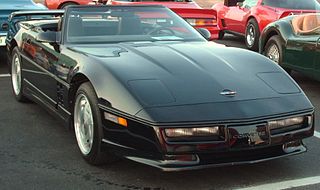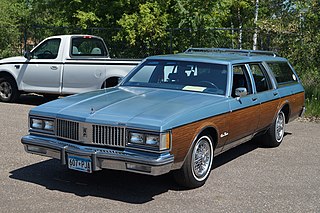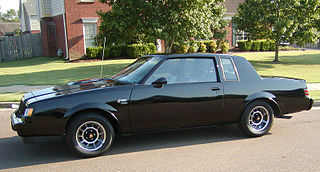Related Research Articles

Oldsmobile was a brand of American automobiles, produced for most of its existence by General Motors. Originally established as "Olds Motor Vehicle Company" by Ransom E. Olds in 1897, it produced over 35 million vehicles, including at least 14 million built at its Lansing, Michigan factory alone.
The H platform, or H-body, refers to two different automobile platforms produced by General Motors.

The Y platform, or Y body, designation has been used twice by the General Motors Corporation to describe a series of vehicles all built on the same basic body and sharing many parts and characteristics. The first was for a group of entry-level compacts including the conventional front-engine compacts built by GM divisions Buick, Oldsmobile and Pontiac from 1961 to 1963. The second, and current, incarnation is used for a high-end rear-wheel drive sports-car platform from the 1970s through the 2000s.

The General Motors 60° V6 engine family is a series of 60° V6 engines produced for both longitudinal and transverse applications. All of these engines are 12-valve cam-in-block or overhead valve engines, except for the LQ1; which uses 24 valves driven by dual overhead cams. These engines vary in displacement between 2.5 and 3.4 litres and have a cast-iron block and either cast-iron or aluminum heads. Production of these engines began in 1980 and ended in 2005 in the U.S., with production continued in China until 2010. This engine family was the basis for the GM High Value engine family. These engines have also been referred to as the X engines due to their first usage in the X-body cars.

The Buick V6 was an OHV V6 engine developed by the Buick division of General Motors and introduced in 1962. Originally 198 cu in (3.2 L) and initially marketed as Fireball, it later became popularly referred to as the 3800 for its various 3.8 L (230 cu in) incarnations.

The W-platform was a General Motors automobile platform underpinning both mid size and full-size front-wheel drive cars. Originally code named GM10, the program began development in 1982 under Chairman Roger B. Smith and debuted in 1987 with the Pontiac Grand Prix, Buick Regal, and Oldsmobile Cutlass Supreme coupés — with the four-door sedan body style introduced for 1990.

The General Motors N platform was a front-wheel drive compact automotive platform produced from 1984 to 2005. The GM N platform was based on the GM J-Body and replaced the GM X platform.

The Pontiac Phoenix was a compact car that was sold from 1977 to 1984 by Pontiac. There were two generations of the Phoenix, both based on popular Chevrolet models, and both using the GM X platform designation. It was named for the mythological Phoenix, which would die in a self-inflicted fire and be reborn from the ashes. The Phoenix was replaced by the Grand Am in 1985.

The B platform is a full-size, rear-wheel drive, body-on-frame car platform, that was produced by General Motors (GM) from 1926 to 1996. Originally made for Oldsmobile and Buick, all of General Motors's five main passenger car makes would use it at some point. It was closely related to the original rear-wheel drive C and D platforms, and was used for convertibles, hardtops, coupes, sedans, and station wagons. With approximately 12,960,000 units built, divided across four marques, the 1965-1970 B platform is the fourth best selling automobile platform in history after the Volkswagen Beetle, Ford Model T, and the Fiat 124.

The Oldsmobile Custom Cruiser is an automobile that was manufactured and marketed by Oldsmobile from 1971 until 1992. Marking the return of Oldsmobile to the full-size station wagon segment, the Custom Cruiser was initially slotted above the intermediate Oldsmobile Vista Cruiser, ultimately above the later mid-size Oldsmobile Cutlass Cruiser.

The Pontiac Parisienne is a full-size rear-wheel drive vehicle that was sold by Pontiac on the GM B platform in Canada from 1958 to 1986 and in the United States from 1983 to 1986. Right-hand drive models were locally assembled in Australia, New Zealand, and South Africa until 1969. For most of its run, the Canadian Parisienne was nearly mechanically identical to the American Chevrolet Impala or Chevrolet Caprice. The Parisienne wagon continued under the Safari nameplate until 1989. Parisienne or La Parisienne means a grammatically female person or thing from Paris, France.
Turbo-Hydramatic or Turbo Hydra-Matic is the registered tradename for a family of automatic transmissions developed and produced by General Motors. These transmissions mate a three-element turbine torque converter to a Simpson planetary geartrain, providing three forward speeds plus reverse.
Arlington Assembly is a General Motors automobile factory located in Arlington, Texas. The plant has operated for more than 60 years and today manufactures large SUVs from GM's divisions Chevrolet, GMC and Cadillac.

The General Motors G platform was an automobile platform designation used for mid-sized rear-wheel drive cars. It made its first appearance from the 1969 to 1972 model years, adapted from GM's A-body, and reappeared from 1982 to 1988. The second series of G-bodies began production designated as A-body cars in 1978, but were redesignated as G-body when the new front-wheel drive A-body platform was introduced in 1982.

The General Motors H platform is an automobile platform used by subcompact cars from the 1971 to 1980 model years. The first subcompact car design developed by GM, the rear-wheel drive H platform initially underpinned the Chevrolet Vega and its Pontiac Astre counterpart. For 1975, the H platform was expanded from entry-level vehicles to sport compacts, adding the Chevrolet Monza, Buick Skyhawk, Oldsmobile Starfire, and Pontiac Sunbird.
The GM A platform was a rear wheel drive automobile platform designation used by General Motors from 1925 until 1959, and again from 1964 to 1981. In 1982, GM introduced a new front wheel drive A platform, and existing intermediate rear wheel drive products were redesignated as G-bodies.

The General Motors A platform was a mid-size platform designation used from 1982-1996. The same designation had previously been used for rear wheel drive mid-sized cars.
In the context of the automobile industry, downsizing is a practice used to transition vehicles from one size segment to another. Commenced during the Malaise era, downsizing is done in response to consumer and government demands influencing vehicle design. As vehicle product lines completed their model cycles, automobile manufacturers developed the next generation of a vehicle with a smaller exterior footprint to allow for weight reduction and increased fuel economy, using a shortened wheelbase and body length.

The General Motors X platform is an automobile platform designation that was used for compact cars with rear-wheel drive. Developed by Chevrolet, the architecture was produced from the 1962 to 1979 model years. During the 1970s, the platform was used by multiple GM divisions as the company expanded its use of compact model lines.